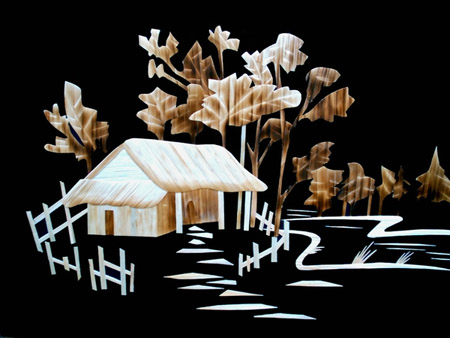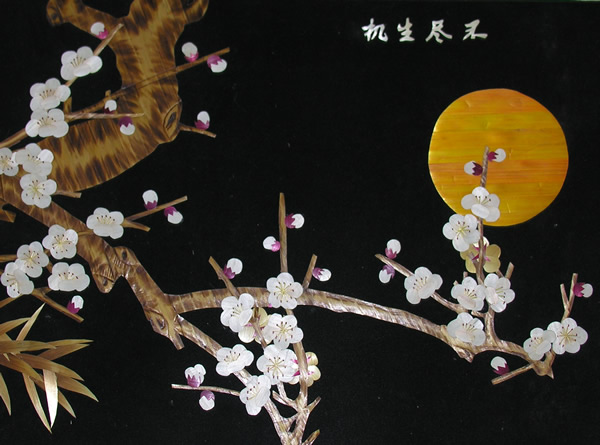
在大多數人看來,麥秸隻不過是麥子成熟後留下的一堆雜草,似乎沒有特別的用途,但這些麥秸經過能工巧匠的精巧運用,就會變成盛開的臘梅、振翅欲飛的雄鷹、清高淡雅的竹子……
麥秸畫,又叫麥稈畫、麥草畫或麥秸畫,是始於隋唐時代的宮廷工藝品。它和剪紙、布貼一樣是一種剪貼藝術。作為我國美術園地裏的一種新品種,麥秸畫被譽為美術苑地裏的奇葩。
麥秸工藝品曆史上曾一度出現,但通常把麥秸染然後再拚貼成圖案,以求得工藝品效果。麥秸畫的技藝更高,它的主要特點是以精選麥秸為原料,經過除膜、切片、劈絲等加工處理,運用拚貼、鏤刻、鑲嵌等製作方法,按照平麵、浮雕、立體等構圖造型,並熟練地利用麥秸(杆)原有的光澤、獨有的紋理,巧妙設計,精工細作,通過麥秸的明暗、深淺、厚薄、疏密等等搭配,以及點、線、麵的合理布局來表達,表現創作者對真善美的理解,對藝術的追求。

麥秸畫的材料隻有一種――小麥麥稈。民間藝人利用麥秸自然光澤和搶撕成絲的特性,經燙色,經過"熏、蒸、漂、刮、推、燙、剪、刻、編、繪"等多道工序,並根據需要進行剪裁和粘貼。顏色全部用烙鐵燙出來,無任何染色。金子般的顏色,然後通過深淺不一的色彩過渡,達到單一顏色表現整體色彩的效果,比如鴛鴦的每一片羽毛都經過由淺到深的色彩處理。
麥秸畫具有特殊的表現力,但它也有一定的局限性。為了突破傳統麥秸畫在表現題材方麵的局限,手工藝人們廣泛吸收現代繪畫的藝術手法,通過精心設計,改革工藝等方式,不斷拓寬麥秸畫的藝術表現範圍。同時,麥秸畫又將傳統工藝與現代科學技術有機結合,在保持麥秸自然光澤和紋理的基礎上,大膽吸收國畫、版畫、剪紙、烙畫等諸多藝術表現手法,巧妙製作成古相典雅,富麗堂皇、惟妙惟肖、栩栩如生的手工藝精品。

麥秸畫分字屏、畫屏,已製作出玻璃鏡框與油漆硬板兩種幅麵,掛式立式座式,大中小型齊全、多種字畫圖案。麥秸畫屬純手工藝術品,它用料環保,形象逼真。雖製作艱辛,但它表現出的藝術效果令所有印刷品望塵莫及。
麥秸畫古樸典雅,惟妙惟肖,富有有立體感層次感,散發出自然光澤,極其賞心悅目。一般運用國畫形式構圖。麥秸畫具有光澤透亮、裝鈽效果好、藝術感染力強等優點,製作出的人物、花鳥、動物栩栩如生,活靈活現,給人以古樸自然,高貴典雅之美。畫人物,惟妙惟肖,做動物,栩栩如生;描林海,飄逸灑脫,繪江河,氣勢雄渾;用它裝飾客廳、臥室、辦公室,情趣高雅,與眾不同。

麥秸畫工藝品,全國很多地區部有生產,以哈爾濱、潮州南陽、浦江和廣西等地生產的較著名。
麥秸畫是我國古文化藝術的一塊瑰寶。但長期以來難覓其蹤,直至秦懷王墓發掘時才出土麵世。雖經兩千多年腐蝕,但仍造型逼真,色澤鮮明,不失其古樸典雅本色,令人歎為觀止。後經有關專家精心研究,這一古老工藝終於重現人間。麥秸畫的發展雖幾經周折,仍以其頑強的藝術生命,在民間藝術的殿堂裏獨秀一枝,綻放異彩。

被譽為“中國民間藝術一絕”的麥秸畫藝術精品,正源源不斷的走向全國,走向世界。因麥秸畫金碧輝煌、富貴高雅的視覺效果與獨特新穎、雅俗共賞的藝術效果,深受行家與觀眾的青睞。近年,麥秸畫已走向日本、韓國以及歐美、東南亞國家、港台市場,成為饋贈禮品與旅遊紀念品,也被藝術愛好者收藏。
麥秸畫DIY:
一、原材料。麥秸、各色染料、乳膠或漿糊、黑絨布或黑絨紙、漂白粉、棉絲紙等。
二、工具。中小號輕便剪刀、裁紙刀、繪畫用品、玻璃紙、調色工具、水盆或大鋁鍋、毛巾、電熨鬥、毛筆、板刷、各式刻刀、針、粉撲、鑷子。
三、選料。宜選粗壯、圓挺、有光澤的麥秸。選好的麥秸去掉頂梢和根節部,隻取中間部分。用小尖刀將麥秸從中間剖開,壓成條片狀,刮去裏麵的薄膜。

四、染色。經過挑選的麥秸用漂白粉溶液漂洗,使其潤白、潔淨。如果設計要求隻用原色(不需染色),應精選色澤一致、無髒汙的麥秸。雖說是原色,但也可將麥秸做成麥秸紙後,用電熨鬥燙成濃淡、深淺不同的赭、棕、黃等色調。凡需染色的麥秸要經水煮脫脂,也有用米湯浸泡的,之後才能放入顏料液中染色。染色時要勤翻動麥秸,防止色調不勻。
五、製麥秸紙。經染色後晾幹的麥秸,逐條緊靠用膠水貼在棉絲紙上,製成麥秸紙。要求麥秸之間沒有空隙,也不要重疊。粘貼時,刷膠要均勻,用膠量要適宜。膠多了,易從麥秸縫間溢出,弄髒麥秸;膠少了,粘不牢,使麥秸紙出現漏缺。
六、設計。麥秸畫的設計與繪畫大致相同,設計時要充分考慮麥秸上的自然絲紋,利用它剪貼後呈現出的橫、平、豎、斜的光亮,來表現畫的色彩和品位。設計中要使麥秸的色調和光澤自然和諧,主調明確,主題突出,不可雜亂無章。
七、作底稿。小圖案不用作底稿,較大幅或複雜的圖案需要底稿。方法是:將透明玻璃紙放在設計圖稿上麵,按照圖樣輪廓用針紮刺出許多小孔。然後將紮刺出圖案輪廓的玻璃紙放在準備加工成麥秸畫的底板上,以粉撲在其上不斷拍按或輕擦,圖樣即清晰地印上底板。

八、剪貼。把麥秸紙按照設計圖樣的需要剪成若幹部分,然後用膠粘貼在底板各相應部位上,即成一幅畫。剪貼的技法主要有以下幾種:
1.平貼法:主要用線或麵來表現物體的形狀、色彩和透視、解剖關係等。
2.拚堆法:運用兩片以上的麥秸紙部件拚貼而成,適宜表現人物的佩飾、器皿上的紋飾和古建築上的彩畫等。
3.層遞法:運用麥秸染色加工後色澤深淺、濃淡的不同,層層粘粘,以表現物像的遠近、虛實等關係。
4.排列法:根據物像的形狀,有次序、有規律地排列粘貼,如表現魚鱗、鳥羽及房屋上的琉璃瓦等。
九、整理裝框包裝。剪貼完成後,對照原稿看有沒有漏掉的部位。檢查認為滿意後,裝入已做好的玻璃畫框中即告完成。
Straw patchwork is a well-known Chinese art and boasts a history of over 2000 years, as evidenced by ancient relics. It traces its roots to folk art, originating as handicrafts used by local governments to pay tributes to emperors during the Sui Dynasty. This artwork constitutes the essence of Chinese folk art, and has a distinctive national characteristic.
.jpg)
Straw patchwork is handcrafted, and takes full advantage of the straw’s natural glow and its material to depict landscapes, flowers, animals and human figures. The visual images and wonderful handicraft is not only a good reflection of profound traditional Chinese culture, but also a wonderful artwork used as decorations.
The straw patchwork is exquisite with its choice of material, because of its good natural sheen of a golden color. The artistic techniques used in straw artwork are borrowed from many other art forms such as paper cut, print, paste, painting, etc. Each patchwork requires a process that is more than ten steps long. The process includes polishing, bleaching, steaming, ironing, pressing, and cutting of materials. The process cleverly combines together a variety of techniques showcasing skilled workmanships, such as traditional Chinese parings and printing, which works in sync with the straws natural colors.
.jpg)
All these techniques bring forth a rich expression of the straw artworks, making it a unique art form with artistic features that is both simplistic yet elegant.
Then what is wheat straw? Wheat straw has long been regarded as a sacred object in Chinese beliefs. It is said that Liu Xiu, the Dong Han dynasty emperor, was hunted by his enemies before he ascended the throne. He had no choice but to hide in wheat straw, which immediately changed into wood to protect him. Since then wheat straw has been considered a symbol of good fortune. So the Chinese people made wheat straw patchwork, a unique art form devoted to the royal court.
.jpg)
Modem pieces are produced by combining modern production techniques with the traditional techniques. Modern art techniques are applied in the manufacturing process, for example, evaporation, dissection and ironing. But it is filled with a rich Chinese countryside flavor. The final products portray Chinese flowers, birds, worms, landscapes, buildings, people and fashions. The quality of the workman ship combined with outstanding artistry further contributes to the work's lasting value.
Straw patchwork owes its popularity to its bright vibrant colors which does not fade and its simple, lifelike designs. The artifact is a combination of primitive simplicity and elegance of exquisite craftsmanship. Furthermore, it is able to retain its original texture and color for up to thousands of years without aging or fading.
.jpg)
This ancient art disappeared for awhile but was soon revived in the 1970s, when these ancient straw patchwork relics were discovered.
The straw patchwork, with its excellent detailing showcasing the works of talented Chinese artists, are highly enjoyed and appreciated by both the Chinese and Westerners. It is used to both decorate and beautify homes and offices, and is also often given as gifts.








